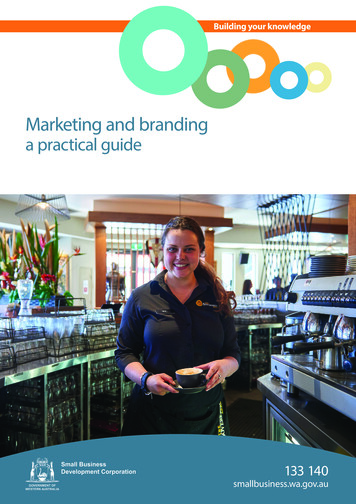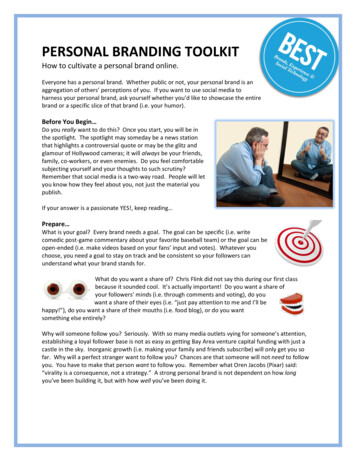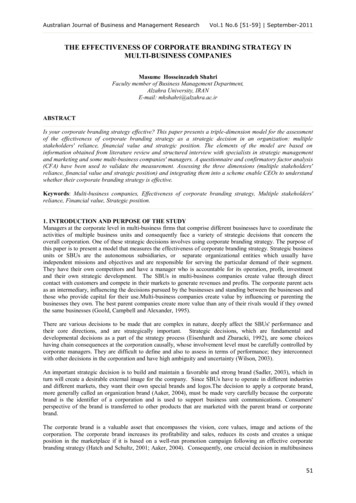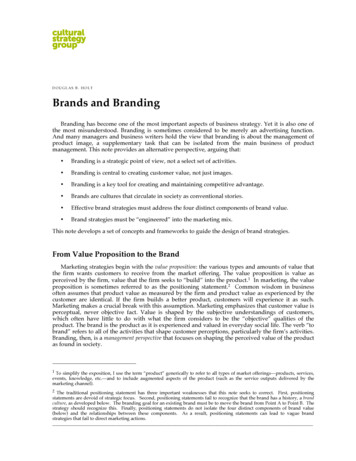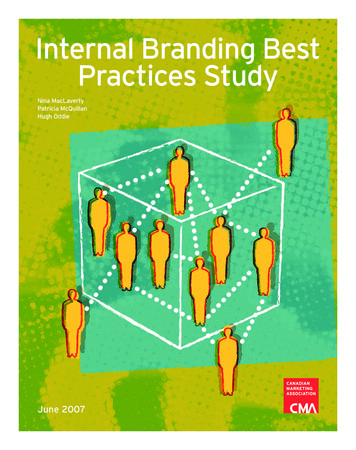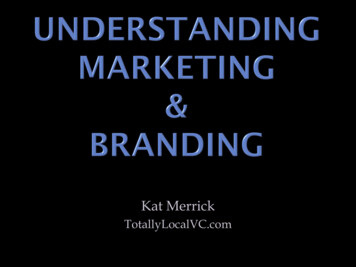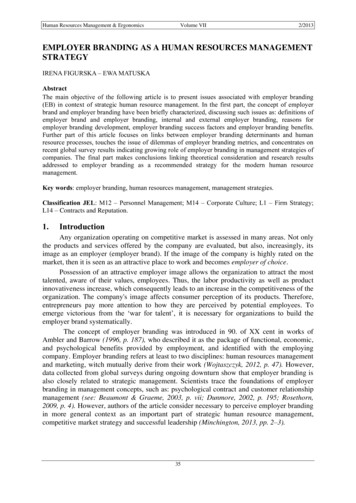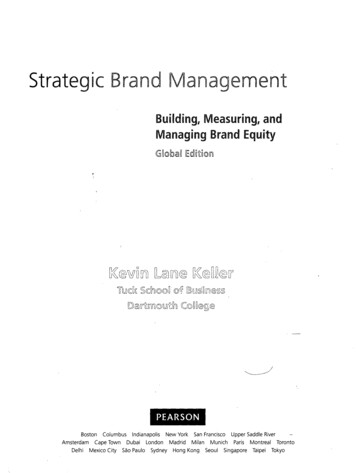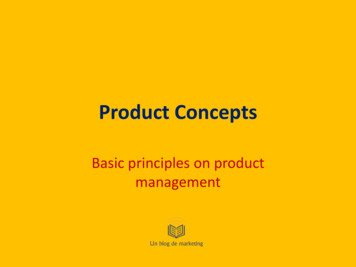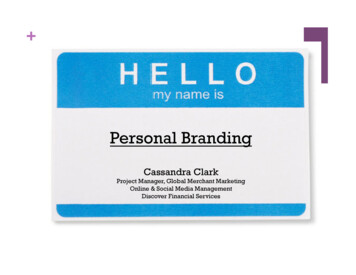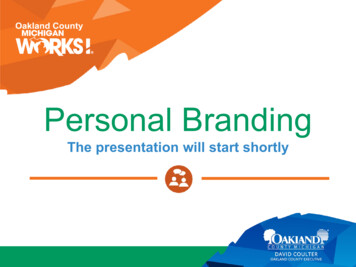
Transcription
Personal BrandingToolkit
Personal Branding ToolkitThis e-book is published by:Mind Tools Ltd, 3rd Floor, The News Building,London Bridge Street, London, SE1 9SE, UK.Copyright Mind Tools Ltd 2017. All rights reserved.“Mind Tools” is a registered trademark (US 4,566,696,EU 012473377) of Mind Tools Ltd.Version 1.0.This publication is protected by international copyrightlaw. You may use it if you have downloaded it directly fromMindTools.com, or if you have been provided with it undercorporate license.Please contact copyright@mindtools.com if you’ve receivedthis from any other source.Cover image Getty Images/JeremyRichardsPersonal Branding Toolkitwww.mindtools.comPage 2 of 44
ContentsWelcome4Executive Summary5Introduction6Chapter 1Who Am I?71.1Identifying Your Strengths (and Weaknesses)81.2Discovering Your Personality Traits121.2.1 Taking the Test131.3Exploring Your Values141.4Picturing Yourself161.4.1 Your Dress161.4.2 Your Body Language161.4.3 Your Manner16Summary18Chapter 2What’s My Unique Selling Point?20Chapter 3Who Is My Audience?253.1Prioritizing Members of Your Audience273.2Understanding Your Audience273.3Giving Your Audience Members What They Want30How Do I Interact?Exploring Your Emotional Intelligence3131Listening to Your Audience35How Do I Get Noticed?375.1Your Personal Brand Statement375.2Your First Steps385.3Promoting Yourself More Widely395.4Making It Happen41What’s Next?431.5Chapter 44.14.2Chapter 5Chapter 6Thank YouPersonal Branding Toolkit44www.mindtools.comPage 3 of 44
WelcomeIt’s time to change howpeople see you – and totransform your career!Have you ever wondered why certain colleaguesseem to get ahead so quickly – and asked yourselfhow you can do the same?This toolkit is designed for ambitious people who areworking hard, but who aren’t getting the recognitionthat they deserve. Often, their “personal brand” isholding them back.So, we’ll help you to develop a strong, authenticpersonal brand that you’ll feel comfortable with,covering everything from how you carry yourself, tohow you work with others.Enjoy using this workbook, and enjoy being noticed– for all the right reasons!James ManktelowCEO, MindTools.comPersonal Branding Toolkitwww.mindtools.comwww.mindtools.comPage 4 of 44
Personal Branding Toolkit –An Executive SummaryHere’s a summary of the key learningpoints covered in this toolkit:Personal Branding is about understandingwhat you have to offer and presenting that to theoutside world consistently. It’s about being true toyourself, so that colleagues, managers, customers,and potential employers have an authentic pictureof you that they can trust.By exploring your core values, personality,strengths and skills you’ll ensure the imagethat you present is true to you. You want to feelcomfortable with your personal brand. That way,you can deliver and earn trust and respect. Yourpersonal brand is a view of the whole you – whatyou stand for and what you believe in, as well asyour strengths and skills.First impressions are important in personalbranding, so being aware of how you’re seen byothers is an essential step toward showing yourselfin your best light. How you look and sound, whatyou say, your body language – all contribute to howyou’re perceived by others.You have an audience to promote yourself to, soyou’ll need to get to know its members and theirneeds well, before you start to “sell” to them.Understanding how you interact with others isalso a big part of personal branding. Exploring youremotional intelligence and listening skills will helpyou to enhance this aspect of your brand – and todeliver it.Promoting yourself clearly and powerfully,whether face-to-face or online, needs to bethought through carefully. Which channelsare available to you and which would be mostappropriate for your “campaign”? You’ll want tobe more visible and memorable, but only for theright reasons!Building and maintaining your brand is acontinual process. Just as you, your workplace andyour life outside of work will continue to evolve, somust your brand. It’s something that you’ll need towork on throughout your career.You want to stand out from the crowd but you stillwant to be you. This means identifying, promotingand developing your unique selling point.Personal Branding Toolkitwww.mindtools.comPage 5 of 44
IntroductionYou want to be noticed. You want to present an attractiveand inspiring image to those around you, but sometimesit’s hard to find the right balance between “blowing yourown trumpet” and underselling yourself.It’s tempting to think that we have to conform tosome “ideal” persona when thinking about ourpersonal brand. But that really isn’t the case. All weneed to do is be ourselves.So, the first step in presenting your brand to theworld is knowing who you are. And that’s exactlywhere this toolkit starts, by asking Who am I? You’llgain a deeper understanding of you: from yourvalues and strengths, to your essential personality,and how you present yourself physically.Set aside time when you won’t be distracted andwork through the steps at your own pace. There areseveral exercises and questionnaires to completein this section, and it’s best to take time out toreflect on your responses, rather than hurryingthrough the chapter in one sitting.Enlisting the help of a good friend or colleague forsome of the exercises can be of enormous benefit.We may think we’re brilliant, but it takes a valuedfriend to point out, in the nicest possible way, thatwe’re not as punctual, appropriately dressed, orflexible as we’d like to be!Personal Branding ToolkitIn the second section of this Personal BrandingToolkit, you’ll identify your Unique Selling Point(USP) and what value you personally bring to yourteam and organization. You’ll then have a muchclearer idea of what sets you apart from your“competition.”Next you’ll be considering who your audiencemembers are, from your closest co-workers, toindustry experts and your social media followers.You’ll consider what’s important in their livesand how you can contribute to their goals whilestill delivering your own responsibilities andmaintaining your integrity.You’ll need to build strong and effectiverelationships to market yourself well, so chapter 4helps you to explore how you interact with people.And then it’s time to get noticed, without feelingyou’re either selling yourself short or over-icingthe pudding!Finally, you’ll be deciding on your long- and shortterm goals. What actions are you going to take nowand in the future to build your brand? Read on tobegin finding out!www.mindtools.comPage 6 of 44
1. Who Am I?Just as a company’s logo, slogans and behaviors revealits brand, you need a clear and impressive image ofyourself to present to the world. So, the first step inpersonal branding is to know who you are.People are often tempted to present an image thatis at odds with who they really are, in order to landa job. But, getting stuck with a persona that isn’tthe real you can lead to stress and failure in thelong term. Promoting an authentic image meansthat you’ll be consistent, and people will feel theycan trust you.Doing what you love and what sits comfortablywith you leads to happiness and fulfillment. What’smore, the people around you will be charmed byyour enthusiasm and positivity.We’ll then look at your personality style, using theBig Five Personality Traits Model. Knowing howyou prefer to work and what energizes you allowsyou to build up a more accurate picture of yourself.Next, you’ll identify your personal values sothat you can ensure that the image you presentis consistent with what you believe is mostimportant in life.Enjoy this journey – it will give you a clearer idea ofwhat you should be presenting to the world.So, we’ll start by determining your strengths andweaknesses, using SWOT Analysis. This toolhelps you to maximize your Strengths, understandyour Weaknesses, and take the greatest possibleadvantage of Opportunities available to you, whileguarding against Threats.123456Who Am I?What’s MyUnique SellingPoint?Who Is MyAudience?How Do IInteract?How Do I GetNoticed?What’sNext?Personal Branding Toolkitwww.mindtools.comPage 7 of 44
1.1Identifying Your Strengths (and Weaknesses)You use your skills, knowledge and experiencesuccessfully every day in your job, so you can besure that you have plenty of strengths to offer. Butare there more that you’ve not had the opportunityto use yet?Are you nervous of sharing your expertise, orunaware that anyone needs it? Or, perhaps you’reembarrassed by a weakness and are keeping itfirmly under wraps. Well, now is the time for somehonest self-reflection.ACTIONAnswer the following questions from your ownperspective, and from that of the people aroundyou. Don’t be modest, but do be realistic.After all, there’s no point in putting yourselfforward as a public speaker if you’re terrified ofgiving presentations!STRENGTHSWhat do you do well, or have good qualifications for?What do others see as your strengths?Which of your achievements are you proudest of?What respected networks, formal or informal, are you part of?What other particular strengths do you have?Personal Branding Toolkitwww.mindtools.comPage 8 of 44
WEAKNESSESWhat tasks do you usually avoid because you don’t feel confident doing them?Do you have traits that hold you back in your role?What are others dissatisfied with in your work?What’s your biggest self-doubt, professionally?What other particular weaknesses are you aware of?Personal Branding Toolkitwww.mindtools.comPage 9 of 44
OPPORTUNITIESWhat industry and technology trends might allow you to use your expertise?What needs can you identify in your company that you might fulfil?How could you turn your strengths into opportunities?What training would help you to address a weakness in your skills?What other useful opportunities do you have?Personal Branding Toolkitwww.mindtools.comPage 10 of 44
THREATSWhat threats to your reputation do your weaknesses expose you to?What threats do you face from competition from inside and outside your company?How do you undermine your own success?What other threats to your personal brand do you face?This self-examination is an example of a personalSWOT analysis. You can find out more about thispopular tool and download a worksheet to helpyou to continue the process, atwww.mindtools.com/personalswot.ACTIONCopy your top strengths, weaknesses,opportunities, and threats into the relevantspaces on page 18.You now have a much clearer idea of yourstrengths and weaknesses, as well as theopportunities and threats that you face. Thiswill help you to pinpoint what to promote aboutyourself, and to begin thinking about how todo this.Personal Branding Toolkitwww.mindtools.comPage 11 of 44
1.2 Discovering Your Personality TraitsWhen promoting yourself, it’s crucial that youare aware of and understand your personality.Whatever your intellectual abilities or lengthof experience, these traits will directly affecteverything that you do.The Big Five Personality Traits Model has thefollowing dimensions:The personal brand that you promote needs toreflect your true personality. That way, you’ll beable to deliver what you’re offering comfortably,and keep your clients or organization happy, too.Personality theorists believe that there arecommon characteristics that group us into certainpersonality types.Knowing your type gives you a greaterunderstanding of your behavior, so that you canpromote yourself authentically.You can use the Big Five Personality Traits Modelto identify your most important personality traits.Routinely used in business and more widely,this broadly respected scale measures fivekey dimensions.As you can see from the description that follows,knowing more about these traits will help you todecide what kind of roles you’ll likely excel at andwhich aspects of your personality you could beemphasizing more.Personal Branding Toolkit Openness (sometimes called intellect orimagination) – This measures your level ofcreativity, and your desire for knowledge andnew experiences. Conscientiousness – This looks at how muchcare you take in your life and work. If you scorehighly in conscientiousness, you’re organizedand thorough, and you know how to make plansand follow them through. If you score poorly,you’ll likely be lax and disorganized. Extraversion/Introversion – This dimensionmeasures your level of sociability. Are yououtgoing or quiet? Do you draw energy from acrowd, or do you find it difficult to work and bearound others? Agreeableness – This dimension looks atyour level of friendliness and kindness. Doyou have empathy? Can you sympathize withother people? Natural Reactions (sometimes called emotionalstability or neuroticism) – This measures yourlevel of emotions. Do you react negatively tobad news and yell at your colleagues, or doyou react calmly? Do you worry constantlyabout minor details, or are you relaxed instressful situations?www.mindtools.comPage 12 of 44
1.2.1 Taking the TestYou can take a version of the Big Five PersonalityTraits Model test at www.outofservice.com/bigfive.Answer the questions as objectively as you canor, for the most accurate results, complete the testwith a co-worker or friend. The free, tick-box testshould take about 15 minutes to complete, andyou’ll get your results straight away.Knowing more about your personality traitsmeans that you’re aware of what’s going to workfor you – and what isn’t. It means that you canmake decisions about the kind of work you wantto attract, based on what you’re good at and whatmakes you happy.There are several versions of the test so,depending on which one you take, you’ll see thescoring presented in different ways. What you willget, though, is a rating for each dimension, whichlets you know if you score high or low comparedwith others who have taken the test.It’s fine to have low scores in openness andextroversion, as there are jobs that need peoplewith this kind of personality. However, it’s a bigproblem if you lack conscientiousness, if you’redisagreeable, or if you’re particularly volatile.Above all, you need to exude professionalism.For instance, your score could look something likethis: O63-C74-E31-A48-N5.ACTIONThe letters stand for the five dimensions and thenumbers stand for the percentage of people whoscored lower than you on that dimension. So,in this example, O63 means that 63 percent ofpeople who took the test scored lower than you inopenness. Therefore, you’re above average in youropenness to new experiences and creativity. C74means that 74 percent of people who took the testscored lower than you on conscientiousness. So,you’re more organized and disciplined than mostwho took the test – this is a very useful insight.In this case, therefore, you’d include the traits ofopenness and conscientiousness in your personalbrand. By emphasizing your desire for knowledge,your creative bent, your willingness to try newexperiences, and your skill at organizing, you’llpresent the real you, and you’ll attract work thatyou enjoy.IMPORTANTWrite down your Big Five Personality Traits scorein the space provided on page 18. List the traitsthat you’d like to emphasize, and describe brieflyhow you could do this to promote yourself.NOTEThe Big Five Personality Traits Model is based onfindings from several independent studies datingback to the late 1950s. Lewis Goldberg iscredited with naming it “The Big Five” in the1990s. But you’ll also find it called “OCEAN,”after the first letters of each dimension.From Goldberg, L.R., ‘The Development of Markers for the Big-FiveFactor Structure,’ Psychological Assessment, Vol. 4, No. 1, 26-42,1992, published by American Psychological Association, Inc.Personal Branding Toolkitwww.mindtools.comPage 13 of 44
1.3 Exploring Your ValuesNow that you’ve considered your strengths andyour traits, it’s time to identify your core values –what’s most important to you about the way thatyou live and work.If you promote yourself in a way that is contrary toyour values, you’ll be uncomfortable and you won’tenjoy your work. For instance, if you’re the sort ofperson who values teamwork and helping others,you might find it difficult to work in a culture wherepeople keep to their own responsibilities and don’tpitch in when the going gets tough.You could be caught in a dilemma where youstrongly want to follow your core values by helpingyour team, even though it’s not expected and couldbe seen as unwelcome or even as a threat.Trying to work in an environment that doesn’tmatch your values means that you have to squashthem to fit in, or stick to them and stand alone.Neither situation is desirable or sustainable.Personal Branding ToolkitThis is particularly relevant if you’re consideringworking internationally. Values such as honestyand reliability are held in common around theworld, but others are more subtle. Some cultures,for instance, have a relaxed attitude to punctuality.So, if you like meetings to start and finish on timeand cannot tolerate lateness, you might need tothink carefully about whether you’d ever fit there.TIPOur “Managing in.” country-themed articles areguides to the etiquette and practicalities ofworking abroad or with global virtual teams.You’ll find them in the Team Managementsection of our website.ACTIONConsider the list of common values on thefollowing page and highlight those that you feelare important – the ones that you want to nurturein your life and work. From these, choose the fivethat are most important to you, and write themdown in the space provided on page 19.www.mindtools.comPage 14 of 44
Figure 1. Common Personal nessAltruismAmbitionAssertivenessBalanceBeing the appinessHard workHealthHelping ner tellectual cyLoveLoyaltyMaking a uenessUnityUsefulnessVisionVitalityTIPYour core values are an integral part of you – they’re not a garmentthat you remove at the end of the day. So, avoid the heartache ofvalue clashes by knowing what you stand for, and presenting thatas part of your personal brand.Personal Branding Toolkitwww.mindtools.comPage 15 of 44
1.4 Picturing YourselfThe physical image that you present to the worldis crucial to your personal brand. This is especiallytrue when you’re meeting people for the first time,as they have little or no other information to helpthem to get an accurate impression of you.But, it’s just as important that the “picture” youpresent at work every day is one that implies yourprofessionalism, confidence and self-worth. Thiswill immediately inspire respect and interest amongyour colleagues.1.4.1 Your DressStart with the way that you dress. Think aboutthe most appropriate dress for the organizationwhere you work to help you to “fit in.” This doesn’tmean that you have to lose your identity: the keyis to conform to some degree. For example, ifyou’re attending a business meeting in a formalenvironment, you’ll likely want to dress smartly,but you can still express your individuality withinthat context.Bear in mind that dress code is specific to eachorganization, and it can vary from a smart jacketand muted colors to jeans and a T-shirt. Forinstance, a multinational bank probably has a strictdress code, but a graphic design company willexpect people to dress less formally. Notice whatothers are wearing and take your lead from them.Whatever the dress code, being clean and tidyis always important. Even if sneakers are thefavored footwear, don’t wear the muddy onesthat you trekked in at the weekend! People makeassumptions about you based on how you lookand, if you take pride in your appearance, you’lllikely take pride in your work, too.Personal Branding Toolkit1.4.2 Your Body LanguageNow think about how you move and speak. Bodylanguage and tone of voice have even more impactthan the words you speak. Facial expressions,gestures and posture speak volumes, as do thepitch and rate of speech. You convey enthusiasmand warmth by smiling, for example, even whenyou’re talking on the telephone.Differences abound in how body language isunderstood, though. For example, in some cultures,standing tall and maintaining eye contact workwonders. But in others, it’s considered rude tolook at someone directly, particularly if he or she issenior to you.TIPFor guidelines on cultural differences in bodylanguage and behavior, see our article atwww.mindtools.com/faux-pas.1.4.3 Your MannerBeing punctual and prepared will add to people’spositive impression of you, but appearing sereneisn’t always easy when you’re under pressure. So,have a look at our infographic on Centering and ourarticle on Hurry Sickness to develop an inner calmthat shows.We’ll look at how you can develop emotionalintelligence and listening skills in Chapter 4.www.mindtools.comPage 16 of 44
ACTIONTake a good look in the mirror, appraise yourworking wardrobe, and observe what the peoplewho you work with wear. Ask a trusted person togive you feedback on your image. Then workthrough the questions below.Describe your daily contacts’ dress code.What does your work wardrobe say about you?What could you do to enhance your image and still “fit in”?How well groomed are you?How do you join a meeting or enter a room – for example, quietly, brashly, head bowed, late?How do you approach other people to begin a conversation – for example, apologetically, warmly?Is there anything that you’d like to do to look and feel better?ACTIONSummarize how you present yourself in thespace provided on page 19.Personal Branding Toolkitwww.mindtools.comPage 17 of 44
1.5 SummaryMy main strengths, which I want to make more widely known:1.2.3.My main weaknesses, and how I could address them:1.2.3.Two opportunities that I could capitalize on:1.2.Two threats that I need to deal with:1.2.My Big Five Personality Test score is:What does this tell you about yourself?Which of the five traits could you make more of?Personal Branding Toolkitwww.mindtools.comPage 18 of 44
My core values are:1.2.3.4.5.The physical image that I currently present to others is:The physical image that I’d like to present to others is:Remember to be as honest and objective aspossible when you’re completing this section.Your personal brand should reflect who you trulyare without embellishments, wishful thinking orfalse modesty.You’ll be able to summarize all of your findings anddecisions about your personal brand on page 41 ofthis workbook. Then, you’ll go on to prioritize andplan the actions that you’ll need to take to makeyour brand a success.If it helps, get a good friend or colleague to give thissummary of attributes a “sense check.”But right now, it’s time to find out how your qualitiescompare with your peers’. Then you’ll know whatmakes you truly unique!Personal Branding Toolkitwww.mindtools.comPage 19 of 44
2. What’s My Unique Selling Point?Your Unique Selling Point (USP) is what makes youstand out from the crowd – the combination of skills,qualities and experience that no one else can offer.Your USP is enormously helpful when it comes to“marketing” yourself. Think of it as what makesyou uniquely valuable to your organization. Afterall, there are probably many people with the samequalifications and experience as you. But, whatmakes you different from everyone else?ACTIONAnswer the questions below and over the pageto begin to explore how you provide value toyour manager, team or organization.(If you’re new to your role, or you’re not veryconfident of your attributes, this may take yousome time.)Give four examples of when your expert knowledge or experience was called on:1.2.3.4.123456Who Am I?What’s MyUnique SellingPoint?Who Is MyAudience?How Do IInteract?How Do I GetNoticed?What’sNext?Personal Branding Toolkitwww.mindtools.comPage 20 of 44
Give four examples of times when you’ve shown initiative or made systems improvements:1.2.3.4.Give four examples of how you’ve improved colleagues’ working relationships:1.2.3.4.Give four examples of going the extra mile to get the work done or to help the team:1.2.3.4.Other characteristics of mine that are particularly valued by my organization and people who I work with:Personal Branding Toolkitwww.mindtools.comPage 21 of 44
ACTIONIn the table below, list the top 10 characteristicsthat you’ve realized are particularly valuable inyour workplace, and identify any “competition”that you have for “supplying” them.Then rank yourself and your competitors with ascore from 1 (poor) to 10 (good).CharacteristicYouCompetitor 1Competitor 21.2.3.4.5.6.7.8.9.10.Personal Branding Toolkitwww.mindtools.comPage 22 of 44
ACTIONPlot the scores from the previous page on thegraph below. Draw a line connecting yourscores, and another for each of your competitors,to highlight where you differ from them.Figure 2. USP cPersonal Branding Toolkitwww.mindtools.comPage 23 of 44
ACTIONUsing all your answers on the previous pagesdevelop a simple, easily communicatedstatement of your USP. This will be made up ofa combination of the areas where you score morehighly than your competitors.My USP is TIP:When you identify your USP, make sure that it’ssomething that really matters to yourorganization and sector. There’s no point in beingthe best in your team for something that peopledon’t care about.Even if you’re certain of your USP, it’s important toprotect, promote and evolve it consistently so thatyour contribution remains clear. You’ll be learningmore about how to do this in Chapter 5 of thistoolkit: How Do I Get Noticed?Personal Branding ToolkitRemember, you’ll summarize all your findings anddecisions about your personal brand on page 41of this workbook. Then you’ll go on to plan andprioritize the actions that you’ll need to take tomake your brand a success.If you’re new to your organization, you might still beunsure about your USP, but try not to worry aboutthis. Instead, concentrate on developing the skillsand knowledge that the people around you need,while you get to know them better. We’ll look athow you can assess and address your “audience”in the next chapter.www.mindtools.comPage 24 of 44
3. Who Is My Audience?So, you’ve explored who you are. You may have foundsome hidden attributes! And you know what makes youdifferent from everyone else in your organization. Now,you need to gain a clear picture of the audience that you’llbe promoting yourself to.ACTIONIf you understand who you’re dealing with, andwhat “makes them tick,” you can showcase theattributes that matter most to them. That way,you’re sure to be noticed and valued!Using the space on the next page, brainstormall the people you routinely deal with now,both inside and outside your organization, plusthose who you want to attract. We’ve givensome examples in the figure below:Figure 3. Example Audience MembersYour bossTrade associationsLendersProspective customersShareholdersCo-workersInterest groupsFuture recruitsGovernmentSuppliersCustomersThe communitySenior executivesThe pressAnalystsYour familyAlliance partnersYour teamThe public123456Who Am I?What’s MyUnique SellingPoint?Who Is MyAudience?How Do IInteract?How Do I GetNoticed?What’sNext?Personal Branding Toolkitwww.mindtools.comPage 25 of 44
My audience members:Personal Branding Toolkitwww.mindtools.comPage 26 of 44
3.1 Prioritizing Members of Your AudienceYou now have a long list of people andorganizations to address. Your next step is todecide which are most important for you to target.Ask yourself whose recognition is most importantfor your career. Base this on how relevant they areto you and how much influence and power theyhave over the work that you do.For instance, you’ll want your co-workers to knowyour personal brand, but they don’t have the powerto make decisions about your future. However,what they say about you is influential, so youmay want to consider them as medium or evenhigh priority.Promoting your brand to your boss is probablygoing to be a high priority. But, unless your jobinvolves working closely with the media – or it’ssomething that you want to start doing – the presswill be a low priority for you.ACTIONFrom the list on page 26, select and record yourhigh-priority audience members in the firstcolumn of the table on the next two pages.3.2 Understanding Your AudienceDo you know what your audience members standfor? And what they might want from you?It could be quality of service, innovative ideas, ororganization and forward planning – or somethingthat you’ve never been aware of before. What newprojects are they planning? Could you contribute?You’ll need to understand what they want fromyou to be able to judge exactly what to offer themand how.You’ll find lots of information about organizationsfrom their mission state
Personal Branding Toolkit www.mindtools.com Page 3 of 44 Contents Welcome 4 Executive Summary 5 Introduction 6 Chapter 1 Who Am I? 7 1.1 Identifying Your Strengths (and Weaknesses) 8 1.2 Discovering Your Personality Traits 12 1.2.1 Taking the Test 13 1.3 Exploring Your Values 14 1.4 Picturing Yo
